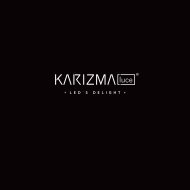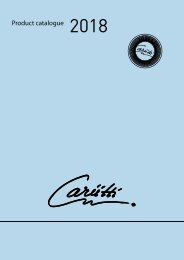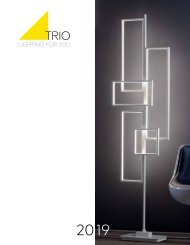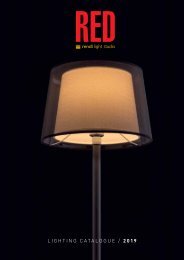VS_2017
You also want an ePaper? Increase the reach of your titles
YUMPU automatically turns print PDFs into web optimized ePapers that Google loves.
Technical Details – Components for Fluorescent Lamps<br />
Lampholders for Fluorescent Lamps<br />
Lampholders for compact fluorescent lamps<br />
Vossloh-Schwabe produces the majority of lampholders for TC lamps using PBT, a thermoplastic material.<br />
This highly heat-resistant material is responsible for the T140 temperature rating. Leading lamp manufacturers<br />
also use PBT for the lamp bases they produce. This material harmonisation in conjunction with<br />
fatigue-free, stainless steel lamp mounting springs ensures a permanently secure lamp fit.<br />
Lampholders for double-ended fluorescent lamps<br />
<strong>VS</strong> lampholders for T lamps are characterised by a number of technical features that guarantee a high<br />
degree of reliability and safety. The heat-resistant PBT rotor with which most <strong>VS</strong> lampholders are fitted is a<br />
recognised trademark. In addition to the lampholders with the field-tested large rotor, <strong>VS</strong> also provides a<br />
new generation of lampholders featuring innovative "Rotoclic" rotor technology. This new <strong>VS</strong> technology<br />
constitutes a further milestone in the development of highly heat-resistant rotor systems.<br />
Among the special features of this new technology is a T140 temperature rating thanks to a front plate<br />
made entirely of PBT as well as a clearly audible click when the lamp is inserted or replaced. As a result,<br />
the motion of turning the lamp from "replacement" to "operating" position is aided acoustically.<br />
In addition to this, <strong>VS</strong> produces a further series of lampholders with a rotor-like function, whose front plates<br />
are also made of highly heat-resistant PBT and have similarly been given a T140 temperature rating.<br />
The maximum permissible temperature at the back of all lampholders is Tm 110 °C. Another key feature<br />
common to all <strong>VS</strong> lampholders is a highly effective support for the lamp pin that reliably prevents any base<br />
pin deflection, even with older lamps, and guarantees a durable and firm contact.<br />
Push-through lampholders<br />
Push-through lampholders are inserted from below through a cut-out in the luminaire casing and are secured<br />
by lateral catches. This type of lampholder is frequently used in luminaires on which the lampholder remains<br />
visible from the outside, e.g. in so-called strip lighting. The electrical leads are laid beneath the sheet<br />
metal level. Luminaire directive EN 60598-1 Para. 8.2 must be observed with regard to the luminaire.<br />
Push-fit lampholders<br />
This lampholder type, which is frequently found in surface-mounted ceiling and built-in luminaires, is pushed<br />
into the luminaire casing from above. The lampholder foot should protrude by no more than 4 mm to<br />
match the usual height of the spacing cams in the luminaire casing. These lampholders are mostly wired<br />
above the luminaire casing to the side of the lampholder. However, there are also lampholders on which<br />
the wiring runs through the lampholder foot, with the leads laid beneath the luminaire casing.<br />
Built-in lampholders<br />
This design is also predominantly used for recessed ceiling and surface-mounted luminaires. However,<br />
unlike push-fit lampholders, built-in lampholders are usually fitted at the ends of the luminaire boxes. In<br />
addition to the usual fixing with split pins attached to the rear, there are also countless versions with fixing<br />
clips, push-fit studs or screw-in holes, which are also available with spring-loaded length compensation.<br />
Built-in lampholders offer luminaire designers a wealth of scope regarding the choice of lamp position in<br />
relation to the reflector. This enables great variation in light distribution as the lampholder does not dictate<br />
the distance of the centre of the lamp from the metal casing.<br />
Surface-mounted lampholders<br />
The fastening system of surface-mounted lampholders usually consists of screws or rivets above a fixing<br />
level, along which the wiring is also laid. As this type of installation is usually too costly nowadays for<br />
large unit numbers, these lampholders are used almost exclusively for special applications, e.g. displays or<br />
illuminated advertisements.<br />
<strong>VS</strong> lampholders for the UL market and UL approved leads are available for all<br />
common lamp types. Further information can be found at www.unvlt.com.<br />
1<br />
2<br />
3<br />
4<br />
5<br />
6<br />
7<br />
8<br />
9<br />
10<br />
229

















